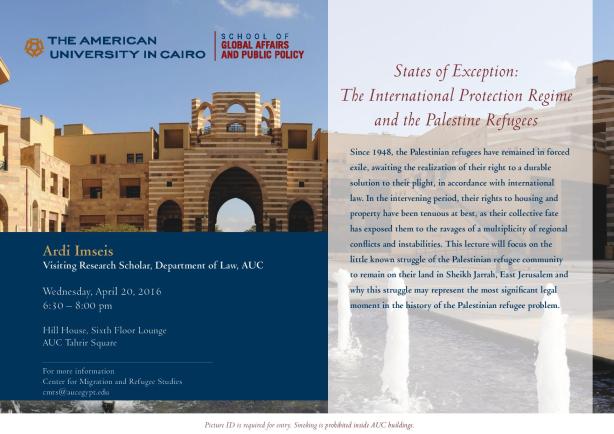
For more than 20 years, Palestinian Refugee ResearchNet has circulated a near-daily digest of news and other items on the Palestinian refugee issue to several hundred subscribers in foreign ministries, aid agencies, international organizations, NGOs, research institutions, and elsewhere. Today, however, will be the very last FOFOGNET Digest.
FOFOGNET (or the “Friends Of the Friends Of the Gavel NETwork”) was originally established in 1996 to support aspects of the multilateral Refugee Working Group in the Middle East peace process. It continued long after the end of the multilaterals, after the broader collapse of the peace process, through several failed efforts to resurrect negotiations, and during crises affecting refugees in Lebanon, West Bank, Gaza, Syria, and elsewhere.
The situation of Palestinian refugees, sadly, remains as adverse as ever. The Syrian civil war, and multiple wars in Gaza, have had devastating social and effects. UNRWA is short on resources. Palestinians, refugees and non-refugees alike, continue to be denied their most basic of rights. There is little or no prospect for political progress in resolving the underlying Israeli-Palestinian conflict in the next several years—on the contrary, the trajectory of the conflict is one that is likely to make it ever-harder to resolve.
I find myself doing less and less work on the topic, which is one reason for discontinuing FOFOGNET. Another is the ready availability of other news aggregation tools which can take its place.
I would like to offer my thanks to those who have contributed material over the years, as well as our subscribers. Special thanks are due to IDRC for supporting FOFOGNET and Palestinian Refugee ResearchNet in its initial years, to Roula el-Rifai, and to Chloe and David Brynen (who have assisted me extensively over the years in finding and posting material).
Archives
A searchable archive of all FOFOGNET materials from September 1998 to August 2013 can be found at the McGill University listerv archives here. Anyone can search this.
The FOFOGNET archives for August 2013-April 2016 can be found accessed via Google Groups. You’ll need to have been a list subscriber to access this.
Rex Brynen
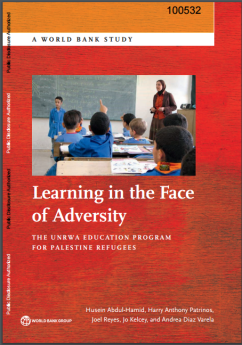 The World Bank recently released a detailed study of UNRWA’s educational services for Palestinian refugees, and the conclusions are generally very positive indeed:
The World Bank recently released a detailed study of UNRWA’s educational services for Palestinian refugees, and the conclusions are generally very positive indeed:
Palestine refugees are achieving higher-than-average learning outcomes in spite of the adverse circumstances they live under. Their education system—the United Nations Relief and Works Agency (UNRWA) for Palestine refugees in the Near East—operates one of the largest nongovernmental school systems in the Middle East. It manages nearly 700 schools, has hired 17,000 staff, educates more than 500,000 refugee students each year, and operates in five areas, including the West Bank and Gaza, Jordan, Lebanon, and the Syrian Arab Republic. Contrary to what might be expected from a resource-constrained administration serving refugee students who continually face a multitude of adversities, UNRWA students outperform public schools in the three regions—the West Bank and Gaza and Jordan—by a year’s worth of learning.
The data below, for example, displays performance on standardized international tests for math and science (TIMSS) and mathematics, science, and reading (PISA). The study does not examine schools in Syria and Lebanon, however.
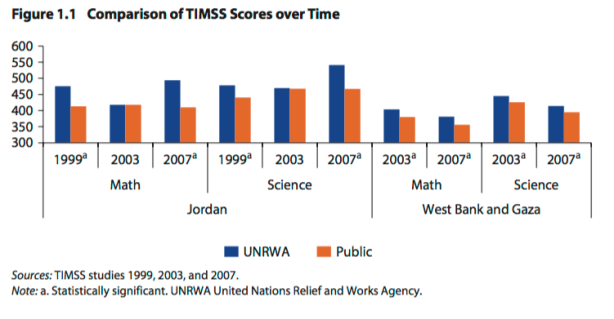
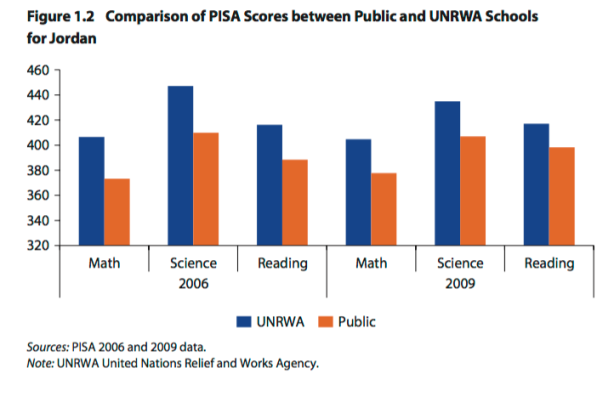
You’ll find a World Bank blog summary by one of the study authors here, with a link to the full report.
Research assistant wanted: The Status of Palestinian Refugees in International Law
Posted: January 26, 2016 by Rex Brynen in employment/internships/volunteers, legal status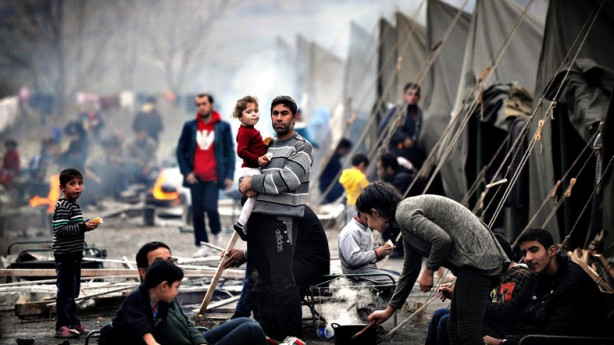
Applications for this position are no longer being accepted. If you have already emailed the researchers you will hear from them in due course. They thank you for your interest!
Research Assistant Position
Second Edition of The Status of Palestinian Refugees in International Law (Oxford University Press).
Summary Job Description
The Research Team for the second edition of The Status of Palestinian Refugees in International Law (SPRIL) is looking for a Research Assistant to support the development of the book.
SPRIL’s first edition was published by Oxford University Press in 1998. The second edition, due by December 2017, will focus on a broad array of legal and political developments occurred since 1998 in connection with the Palestinian Refugee Question.
The Research Assistant’s primary responsibilities will include focused research on secondary and potentially primary sources related to the Palestinian Question and Palestinian refugees in Arab countries, reviewing and summarizing existing literature and responding to ad hoc demands of the Research Team as needed. Sources will include legal and UN documents, history books as well as publications of socio-political interest. Supporting the Research Team in the conduct of structured interviews will also be contemplated.
If the candidate has related experience and interest, the Research Assistant may also assist with other areas of the research including in-the-field research.
Minimum qualifications and requirements to be considered an applicant
Degree in Law, International Affairs, Political Sciences or related areas. Post-graduate qualifications will be an asset.The incumbent will have to possess significant interest in the Palestinian Refugee Question.
Qualifications required
Previous research experience will be considered as a plus.
English proficiency required. Arabic and French will be considered an important asset.
Excellent interpersonal, organizational and communication skills are essential including proficiency with MS office software.
Period
6-12 months part time. Details to be discussed with research team.
Allowance
Provided.
CFP: IJMES Special Issue on Forced Displacement and Refugees
Posted: January 22, 2016 by Rex Brynen in call for papers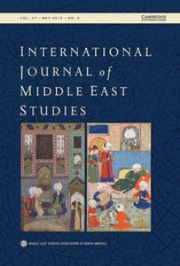 The International Journal of Middle East Studies has issued a call for papers for a special issue on forced displacement and refugees:
The International Journal of Middle East Studies has issued a call for papers for a special issue on forced displacement and refugees:
CALL FOR PAPERS
IJMES Special Issue: Forced Displacement and Refugees
Guest editor Dawn Chatty with IJMES editors Akram Khater and Jeffrey Culang
Forced migration has come to be the defining feature of the contemporary Middle East, a region that is both the source of and host to some of the largest forcibly displaced populations in the world. In 2015, 65 percent of the world’s 19.4 million refugees—including the 5.5 million Palestinian refugees—as well as 30 percent of the world’s thirty-eight million internally displaced persons (IDPs) were in the Middle East, while one out of every four refugees worldwide was from Syria. Seeking security and stability, millions of people from the region are on the move within and across social spaces that are at once strange and familiar, and in which they themselves are familiar and strange to others. In 2015, Turkey became host to the world’s largest refugee population of over two million, while Zaʿatari camp in Jordan has grown rapidly to become one of the world’s largest camps since the Syrian civil war began. With 7.6 million people—or 35 percent of the population—internally displaced, Syria now has the highest number of IDPs in the world. Iraq has produced multiple overlapping displacements, resulting in one of the largest refugee resettlement programs of the past decade. Thousands of Syrians, Libyans, and Iraqis have undertaken perilous journeys across the Mediterranean Sea to seek asylum in Europe and elsewhere. Palestinian refugees are now in a fourth generation of exile, making their plight the longest running unresolved refugee situation in the world.
Although the scale of forced migration in the current moment is unprecedented, it has long been a defining feature of the region’s history. Beginning from the mid-19th century—with what some historians call the first modern genocide of Circassian people—the Middle East has been existentially defined by the stories of displaced and dispossessed people, as well as by communities and associations offering asylum and refuge. However, despite the history of refugees being central to that of the region, refugees’ stories have rarely been at the heart of most narratives. Moreover, the Middle East remains largely bereft of legal national and regional asylum mechanisms, offering instead customary traditions of hospitality and refuge, as well as a patchwork of local responses and bilateral agreements with UN agencies.
For this special issue of IJMES, we seek the submission of papers on the current Syrian displacement, as well as on the Iraqi, Palestinian, Assyrian, Armenian, and Kurdish displacements that preceded or overlap with it. How have communities in and from the Middle East responded to protracted and repeated forced displacement? In a region where displacement is endemic, how have categories of citizen and foreigner, host and refugee, home and exile, emplacement and displacement been reconfigured and reimagined? Has the notion of “crisis” in public and academic discourses been a useful analytic tool to capture regional dynamics? To what extent has displacement been a tool of state building, or a consequence of state collapse? What has been the relationship between displacement, war, and underdevelopment? Has the absence of legal asylum allowed for the emergence of alternative regional coping mechanisms? We are looking for papers that address reception, refuge, protection, and asylum by and for Middle Eastern populations both within and outside the region at any historical moment, and papers that are deeply engaged with the theoretical framing of the refugee as subject and object.
The deadline for submissions is 22 April 2016. Authors should follow the regular guidelines for submitting an article manuscript to IJMES, which are detailed here: http://ijmes.chass.ncsu.edu/submissions.htm. Please indicate in your cover letter that your submission is intended for the special issue. All special issue articles must be accepted individually through the IJMES peer review process.
IJMES submission information can be found at http://ijmes.chass.ncsu.edu/submissions.htm
If you’ve ever wondered where former UNRWA Commisioner-Generals go, here’s your answer. Today UN Secretary-General Ban Ki-moon swore in Filippo Grandi as the new United Nations High Commissioner for Refugees, and Karen Abu Zayd as Special Adviser on the Summit on Addressing Large Movements of Refugees and Migrants.
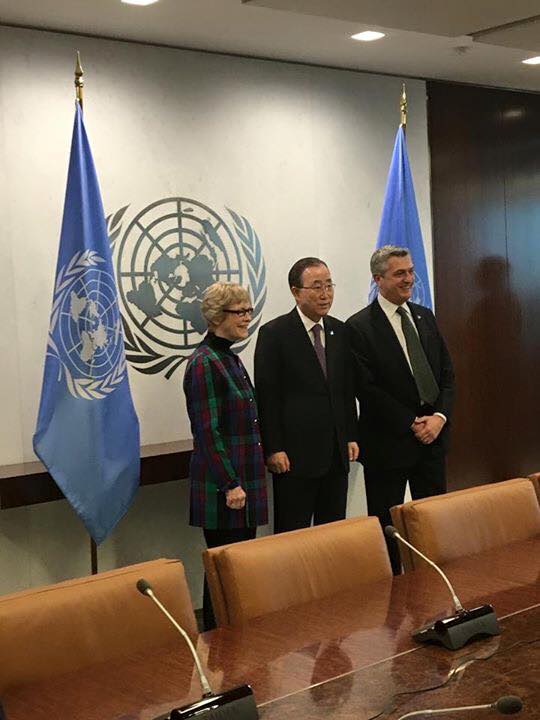
Karen served as UNRWA CG from 2005 to 2010, and Filippo from 2010 to 2014.
Video released by UNRWA on 16 November 2015, showing current situation in Gaza.
Sabra and Shatila 33 Years Later—A Personal Account
Posted: November 10, 2015 by Rex Brynen in LebanonTags: Ellen Siegel, Sabra and Shatila
The following personal account appeared in the Washington Report on Middle East Affairs (November/December 2015). I’m reposting here with the permisison of its author, Ellen Siegel.
To add my own personal note, the Sabra-Shatila massacre—which occurred when I was in my final year as an undergraduate student at the University of Victoria—was the formative event that led me to study Palestinian politics at graduate school and write my PhD thesis on the PLO in Lebanon.
RB
Sabra and Shatila 33 Years Later—A Personal Account
By Ellen Siegel

The author (r) with Bahaa Tayyar, BAS director and senior social worker at the Ein el-Helweh Camp Center. (PHOTO BY SIRKKU KVISTO)
This past September marked the 33rd anniversary of the massacre at the Sabra and Shatila refugee camps in Beirut.
On June 6, 1982, Israel invaded Lebanon and surrounded its capital, Beirut. One aim was to end the control of Beirut by the PLO. The city was under siege, blockaded, and repeatedly bombed, resulting in extensive casualties. On Aug. 21, the U.S. negotiated an agreement which would end Israel’s assault and allow for the safe evacuation of the PLO fighters. Western nations guaranteed that the refugees and civilian residents of the Palestinian camps would be protected by a multinational force (MNF) once the PLO left.
By Sept. 1, the PLO fighters had been evacuated from Beirut under the supervision of the MNF. Remember that this evacuation was conditional on the MNF providing security for the Palestinian refugees in Lebanon. On Sept. 11, however, the MNF departed Lebanon. On Sept. 14 Lebanon’s newly elected president was assassinated. Within days, Israeli forces surrounded the Sabra and Shatila camps, preventing anyone from leaving.
The Israel Defense Forces (IDF), under the leadership of Defense Minister Ariel Sharon, gave permission for the Phalangists (a Lebanese Christian political party and militia, and avowed enemy of the Palestinians) to enter the camps in order “to rid the camps of any fighters left behind and to prevent chaos.” From Sept. 16 to 18 hundreds, possibly thousands, of innocent civilians living in the camps, including many women and children, were brutally slaughtered by this militia under the watchful eye, and with the aid, of the IDF.
During this time, I was working as a nurse at the Gaza Hospital inside Sabra camp and bore witness to much of what happened. I subsequently testified before the Israeli Commission of Inquiry into the Massacre.
Every September I return to the camps to commemorate the massacre—and each year the situation for the Palestinians deteriorates. The 12 UNRWA camps in Lebanon with 455,000 registered Palestinian refugees are extremely overcrowded, and now house refugees from Syria as well. Most living spaces consist of two very small rooms: a bedroom, where the entire family sleeps, and a living room of sorts with a chair or two, maybe a sofa; in addition, there will be a small bathroom and an even smaller kitchen. There is no ventilation, and hardly any electricity. Most families use battery-powered lighting provided by American Near East Refugee Aid (ANERA) and other non-governmental organizations (NGOs). Drinking tap water is prohibited, as it is full of bacteria and very salty—it actually corrodes pipes. Narrow alleyways—some with sewage running through—wind through the camps. When it rains these small paths become muddy.
Electrical wires hang from dwellings. When I first went to Lebanon I noticed those wires. Over the years, I see that they have been strung lower and lower, so that now the top of your head can actually brush up against them. Walk through any camp on any day: you can see young men connecting and re-connecting wires. From time to time, someone is electrocuted.
Foul odors emanate from those crowded conditions. Illness is rampant. In Nahr el-Bard, in the north, there is an impetigo epidemic (a highly contagious skin infection that mainly affects children) due to poor sanitary conditions; some camps have clinics which specialize in treating lice. Nahr el-Bard is in the process of slowly being rebuilt after being leveled in 2007. The construction produces dust and debris which blow into homes and affect those living there. Medications for all illnesses are in short supply.
This year, I noticed a few families living in very small spaces made entirely of tin. In Nahr el-Bard some refugees are still living in containers once meant to serve as temporary shelters.
To add to an already difficult situation, this year a sandstorm hit the Middle East. The air was thick when I arrived; people could hardly see what was in front of them. Most wore masks. In the north, hundreds of people were admitted to the hospital with respiratory complications. A number of them died.
September was hotter than usual. Due to an ongoing trash strike, garbage was piled high in the streets. Almost everyone in my delegation had some sort of intestinal problem.
The Not to Forget Sabra and Shatila Commemoration is organized by the excellent NGO Beit Atfal Assumoud (BAS), the National Institution of Social Care & Vocational Training, directed by Kassem Aina. Our program was full and productive. This year we were joined by a delegation from Palestine representing NGOs in Jerusalem, the West Bank and Gaza. This delegation made our visit even more interesting as its members shared stories of their own day-to-day lives. They were appalled by the conditions in Sabra and Shatila, and remarked that they “were worse than in Gaza.” The leader of the delegation reminded all of us—visitors and camp residents alike—that “the Palestinians are one people no matter where they are…whether they are in the West Bank, Jerusalem, Gaza, Lebanon, Jordan, or in the diaspora. It is one struggle. And the Right of Return must be recognized.”
We visited many camps and broke bread with those living in them. One of the high points for me, always, is the visits with the survivors. I have known many of them for years. I am aware of their aging (as well as my own). I watch as they hold the frames containing faded pictures of those they lost so long ago. The survivors have grown old, their faces lined with wrinkles. Yet they remember their loved ones as they looked way back then—promising young boys, handsome husbands—all looking forward to a future which ended horribly and tragically in September of 1982. A small group of us visited the sparsely furnished home of one of the survivors, who now lives in what was once the hospital and is now a run-down shelter where hundreds of displaced live. She shared with us her story of what happened to her during the massacre.
The re-telling of those days during the massacre is important to me. It allows me to remember the events with her and with the translator (also a survivor). It verifies the moments, the past; it is a way of sharing. It is a means for me, as a non-Palestinian, to deal with what happened. It re-affirms my commitment not to forget the event and to keep that part of Palestinian history alive. At the end of our visit I asked to see pictures of her grandchildren—she remarried after her husband was killed. This small request made her smile. Sharing talk of her grandchildren was a lovely way to end the visit.
Annually, we have lunch with a group of survivors. It allows us to share a delicious home-cooked Arabic meal prepared by BAS in a relaxed atmosphere. These people are our heroes; we want them to feel honored and special. As we’ve come to know them over the years, we share not only their sorrow and resignation, but their steps toward healing. One woman, who in years past was very tearful and sad, and seemed in poor health, looked wonderful this visit. She has lately been receiving excellent health care, and she was smiling and upbeat. One gentleman used to carry a book about his murdered son and always seemed anxious. This year he did not bring the book to the lunch. Instead, he seemed in good spirits and joyfully sat with some of the delegation.
We traveled south to Rashidiyeh camp, on the edge of the Mediterranean, for a special visit. The residents say they like living there because it is “close to Palestine.” We were entertained with a lovely concert by the Assamoud band, debke dance, and poetry readings. For some reason, I always have tears in my eyes when I watch the young generation carrying on their tradition. No matter what the Israelis do, they cannot kill a culture!
The Closing Ceremony
The commemoration program closes with a ceremony that includes survivors, those living in camps, including youth groups, guests and dignitaries at a cultural center close to the cemetery. After several speeches, the participants march from the center to the mass grave. Wreaths are laid, survivors place pictures of those lost close to the wreaths, prayers are said. It is a time to greet friends who come every year, to grieve alongside those who remain.
When I reflect on my visit, I am reminded that there are now four generations of Palestinians in these camps. It is a painful thought. I have had conversations with many of the elderly who came in 1948. At first, these refugees truly believed they would be returning within days to their homes, their groves and orchards in Palestine. They left with just the clothes on their backs. Most had lived quite comfortably, tending crops, working their farmland, raising animals, producing goods. Now they are impoverished. Never did they imagine that 67 years later they would be living in such harsh conditions. The lack of basic essentials that most of us take for granted has become a way of life for them.
The generations that were born there are not aware of how comfortable and profitable their ancestors’ lives were; they know nothing better than their daily reality. Through no fault of their own, these Palestinians have lived out their lives in deplorable refugee camps. I always wonder why Israel has never taken any responsibility for this tragedy.
I have been asked, “Why is this massacre different from other atrocities the Palestinians have suffered? Why is so much attention paid to this one?” I am not sure I can answer. All I know is that the barbarity of what happened is unprecedented and that Israel played a direct role. The U.S. did not “provide safety and security” once the PLO left, despite the promise by President Ronald Reagan’s envoy Philip Habib. The Lebanese who participated were and never will be charged. All parties went free. Israel, America and Lebanon all played a role. Justice has not been done.
A great deal of attention is paid to Gaza. Most organizations are focused on the situation there, and that is understandable. But the conditions in the camps in Lebanon are ignored altogether. Why is this? One organization says that “its goal is to change U.S. policy.” Fine, but what about the decades of day-to-day suffering in the camps in Lebanon? Peace is not at hand; military occupation and violence are not compatible with peace. The conflict will not be resolved soon. Let us help those in need. No doubt, a fifth-generation Palestinian child will be born before long in Sabra and Shatila. Let us make life more tolerable for families and give youths the tools to further educate themselves, to improve their skills—let us allow them to hope for a better future.
The situation of the refugees in Lebanon was created decades ago for political objectives—yet today the refugees remain. They are not abstract political concepts, but individual human beings, generation upon generation, forced to live in conditions that are barely livable. This is the immediate question you can ask yourself, in whatever way works for you, without waiting for others to “solve” the “problem” of the refugees. What can you do?
You can join me for the 34th Commemoration next September. In the interim, you can support the work of ANERA. I am on its Medical Committee and have visited its programs in Lebanon. It does excellent work. ANERA describes its mission as to “advance the well-being of people in the West Bank, Gaza and Lebanon. Through partnerships and close consultations with local groups and communities, ANERA responds to economic, health and educational needs with sustainable solutions and delivers humanitarian aid during emergencies.” I encourage you to visit its website, <www.anera.org>, and consider becoming a donor.
BAS, which organizes our annual commemoration, has many projects in Lebanon—all professionally run and with ongoing training for those who provide services. Some of its programs include sponsorship for children and the elderly, social services for families and children, vocational training, literacy classes, computer training, embroidery production, mental health counseling, dental clinics, reproductive health clinics, and cultural and social activities. The kindergartens in the camps are fantastic—a lovely respite from camp life, giving children some sense of normalcy. One way of supporting BAS is to sponsor a child, a family or an elderly person through its website, www.socialcare.org. For specific sponsorship opportunities visit www.socialcare.org/portal/family-happiness-project/7.
Ellen Siegel, an American Jewish nurse, is a peace activist who has focused her activism on bringing awareness of the situation of the Palestinian refugees in the camps in Lebanon to others. She volunteered her medical services in 1982 during the Israeli invasion of Lebanon. She was working at Gaza Hospital in Sabra Camp during the massacre.
RSC course: Palestine refugees and international law
Posted: November 10, 2015 by Rex Brynen in coursesTags: Refugee Studies Centre
 The Refugee Studies Centre at the University of Oxford will be holding a short course on Palestine refugees and international law in Amman, Jordan on 11-12 March 2016:
The Refugee Studies Centre at the University of Oxford will be holding a short course on Palestine refugees and international law in Amman, Jordan on 11-12 March 2016:
ABOUT THE COURSE
This two-day short course places the Palestinian refugee case study within the broader context of the international human rights regime. It examines, within a human rights framework, the policies and practices of Middle Eastern states as they impinge upon Palestinian refugees. Through a mix of lectures, working group exercises and interactive sessions, participants engage actively and critically with the contemporary debates in international law and analyse the specific context of Palestinian refugees in the Middle East (Lebanon, Syria, Jordan, the West Bank, Gaza and Israel).
The short course commences with the background of the Palestinian refugee crisis, with special attention to the socio- political historical context and legal status of Palestinian refugees in the region. This is followed by a careful examination of the Universal Declaration of Human Rights including its philosophical underpinnings and ensuing human rights instruments in international law. The key themes, which have taken centre stage in the debate on the Palestinian refugee crisis, are statelessness, right of return, repatriation, self-determination, restitution compensation and protection. These themes are critically examined along with current discussions about the respective roles of UNRWA, UNHCR and the UNCCP in the Palestinian refugee case.
This course is suitable for: experienced practitioners; graduate researchers; parliamentarians and staff; members of the legal profession; government officials; and personnel of inter-governmental and nongovernmental organisations.
INSTRUCTORS
Dawn Chatty, Emeritus Professor of Anthropology and Forced Migration, RSC
Susan M Akram, Clinical Professor, Boston University School of Law
Further details and an online application form can be found at www.rsc.ox.ac.uk/palestine
* * *
In addition, the RSC is now accepting applications for their International Summer School in Forced Migration, which will be held in Oxford on 4-22 July 2016.
Applications are invited for the 2016 International Summer Schoolin Forced Migration, to be held at Wadham College, Oxford. The Summer School, now in its 27th year, offers an intensive, interdisciplinary and participative approach to the study of forced migration. It aims to enable people working with and for refugees and forced migrants to examine critically the forces and institutions that dominate the world of the displaced. Beginning with reflection on the diverse ways of conceptualising forced migration, the course considers political, legal and wellbeing issues associated with contemporary displacement. Individual course modules also tackle a range of other topics, including globalisation and forced migration, and negotiating strategies in humanitarian situations.
The participants
The Summer School is principally designed for practitioners and policymakers working with and for refugees and related issues, normally with several years work experience. Participants typically include staff of the main refugee, migration and humanitarian international organisations; staff from refugee, human rights and humanitarian NGOs, and government officials working on refugee protection and related issues.
Participants also include academics and postgraduate and postdoctoral researchers working directly on refugee and forced migration issues; practicing lawyers and advocates working in refugee and human rights law pertaining to forced migrants; journalists, commentators and activists working on refugee protection and the human rights of forced migrants.
The teaching
Lecturers and tutors include research staff, academics and professionals from the Refugee Studies Centre and other world-class institutions, drawn from a number of disciplines and practices including law, anthropology, politics, and international relations.
The course, which is residential, is held in Oxford. Teaching is conducted in English.
Sponsorship
Saïd Foundation bursaries are available for Summer School candidates who work on refugee-related issues from Palestine, Lebanon, Syria and Jordan (or Palestinians and Syrians resident in the Arab world). Candidates wishing to be considered for bursary support must apply directly via the International Summer School office and not contact the donors directly. Please note the deadline for a bursary application to the International Summer School is 1 February 2016.
Should additional funding become available details will be made available on the Refugee Studies Centre website.
Additional details and an online application form can be found at www.rsc.ox.ac.uk/study/international-summer-school
 Today’s Times of Israel has a piece by Ari Krauss entitle “UNRWA has got to go.” Unfortunately it is another example of the poorly-informed debate within Israel on the Agency and what it does (and doesn’t) do.
Today’s Times of Israel has a piece by Ari Krauss entitle “UNRWA has got to go.” Unfortunately it is another example of the poorly-informed debate within Israel on the Agency and what it does (and doesn’t) do.
A few examples:
“It has, from the very beginning, been an organization that has had an interest in managing the problem of the Palestinian refugees rather than solving it.”
- Not at all–UNRWA has been vociferous in calling for a resolution of the refugee issue that it would put it out of business. In the early, optimistic days of the Oslo process it began preliminary planning for service transfer/wind-down in the aftermath of a final status agreement, and it certainly took part in a range of quiet discussions on transitional issues (I know–I organized some of them). It also aligns its service delivery practices with host countries, in part, to make any eventual post-peace transfer of services easier.
“In contrast, the UN Refugee Agency, which deals with all refugees worldwide totaling approximately eleven million, employs sixty three hundred staffers…”
- Only partly true. UNHCR subcontracts most of its actual service delivery, while UNRWA employs teachers, medical personnel directly. If you added employees of subcontracted NGOs to the UNHCR total it would be very much higher. (UNRWA also provides more extensive services.)
“The recent wave of violence has revealed a disturbing trend of calls to incitement of violence on social media. individuals identifying themselves as UNRWA employees in their profiles and even teachers at UNRWA schools have shared and posted images calling for violence against Jews and praising the stabbing attacks that had already taken place;
UNRWA has made no effort to curb these incidents and, as far as anyone can tell, makes no effort to investigate or fire such employees.”
- The first part, regrettably, is true—and while it is hardly surprising that Palestinian employees of UNRWA (almost all from families that were ethnically cleansed from Palestine by Israel in 1948) might hate Israelis, there should be absolutely no tolerance for expressions of this within a UN agency.
- The second part isn’t true. UNRWA does have active and ongoing measures against incitement or violation of political neutrality. UNRWA has taken disciplinary measures against some UNRWA employees, although in my view needs to do more, and to do it more publicly.
“UNRWA has made no effort ensure that it does not employ members of the many terror groups that operate within the West Bank, Gaza Strip, and Refugee camps.”
- Actually, the entire UNRWA employment roster is regularly transmitted to Israel for vetting (although they don’t talk about it a lot, since that’s hardly popular among Palestinians). It also checks its employee lists in other ways. Obviously, in some cases they’ll miss members of extremist groups, just as there are Israeli civil servants or military personnel who support the banned Kach/Kahane Chai Jewish terrorist organization.
“We don’t need to look further than last summer during Operation Protective Edge where UNRWA schools were offended found to be booby-trapped or storage sites for Hamas ordnance. In one shocking case, UNRWA officials claimed that they had turned over missiles found in one of their schools to “the local authorities” as per routine UN practice in these situations. Presumably that means Hamas, who, to the knowledge of counter terrorism experts and Western intelligence agencies, does not maintain an explosive ordnance disposal unit.”
- No UNRWA school was found to be booby-trapped. The IDF did identify one “UNRWA clinic” as booby-trapped, but the claim was false as the IDF later admitted.
- Weapons were found in a couple of UNRWA schools that had been closed for the summer, which was a clear violation of UNRWA’s neutrality policy. It was UNRWA that found the weapons, UNRWA that denounced their presence, and tried to have them removed by liaising with Palestinian police personnel reporting to the Ramallah (not Gaza/Hamas) government. If Krauss had actually bothered to read the UN investigation report on the incident he would know that unknown persons removed the weapons before disposal could be arranged—UNRWA’s statements at the time got this wrong.
- On a side note, the IDF has also made use of UN schools as military positions (even, in one case, as a temporary detention centre) in the past during operations in both the West Bank and Gaza. That too is a violation of UNRWA’s neutrality policy.
“The United Nations High Commissioner on Human rights states that the three primary solutions to refugee problems are “Voluntary repatriation, local integration, resettlement” these solutions only apply to original refugees; would that the Palestinians had not been allowed their special status of being able to pass down their status as refugees to their children than estimates put original Palestinian refugees today at anywhere between thirty and fifty thousand people, a much more manageable number which could have easily been granted the right of return in a peace agreement. Instead, we have a number that has ballooned into the millions and which would be impossible for Israel to absorb.”
- Oh, where to begin…
- UNHCR has an even stronger position than UNRWA on refugees’ “right to return,” and clearly prioritizes the repatriation of refugees for 90%+ of refugees.
- UNHCR recognizes the children of stateless refugees as refugees (“derived status”). Most UNRWA refugees would be refugees under UNHCR rules too. In cases where stateless subsequent-generation Palestinian refugees have been outside UNRWA’s area of operation (for example, Iraq), UNHCR has treated them as refugees.
- Finally, the current Israeli government is not willing to accept the return of ANY Palestinian refugees, so it is a bit disingenuous to suggest that “thirty and fifty thousand people” would be “a much more manageable number which could have easily been granted the right of return in a peace agreement.”
- I happen to agree that large-scale return of Palestinian refugees to Israel is not ever going to happen, and that clinging to an absolute right of return is an impediment to achieving peace. That being said, I’ve yet to meet a Palestinian negotiator who thinks very large numbers of refugees would return to 1948 areas either. The roots of the Palestinian yearning to return to their homeland are not to be found in UNRWA, however, but in forced displacement by Israel. Jews, after all, didn’t need a UN agency to wish to return to Eretz Israel, a yearning they sustained through centuries of diaspora… why think that Palestinians are incapable of that same desire?
There are certainly issues on which UNRWA practices and Israeli preferences (or the preferences of the current Israeli government) do not align. There are also issues on which UNRWA practices and those of the PA, or Hamas, or host countries, or even donors do not fully align. By all means, those are appropriate subjects for discussion.
It does help, however, to get your facts straight.

